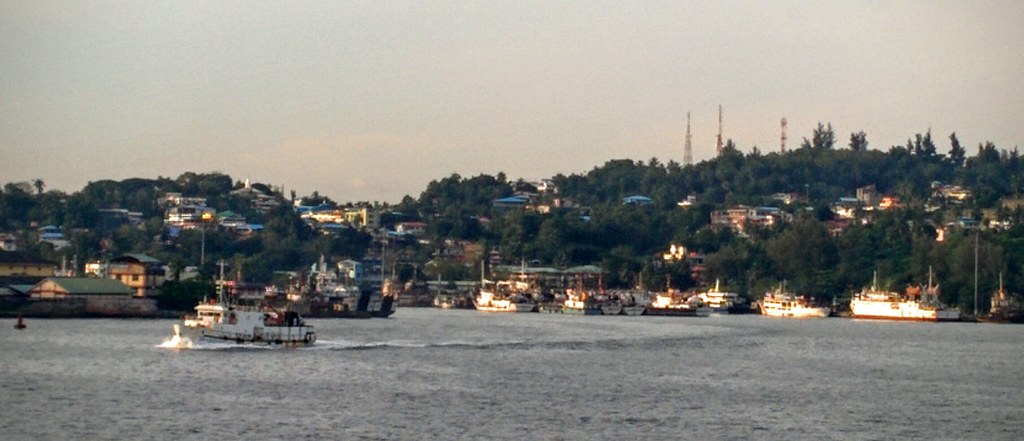#expeditioncruising .
Location: Port Blair, Andaman and Nicobar Islands
You could easily spend some weeks among these isolated islands and still not explore them thoroughly.
The Andaman and Nicobar Islands on the eastern edge of the Bay of Bengal and the western fringe of the Andaman Sea (immediately west of Thailand), is chock full of history, myth and ethnographic conundrums. As such, any visit of just a couple of days is going to leave tantalising questions unanswered.
In the early hours of this morning, Silver Discoverer steamed slowly into the shelter of Port Blair, a protected harbour with a surprising number of vessels moored and anchored around the lush perimeter. Little brightly coloured ferries plied across the water as the sun came up. We were clearly the largest vessel in the harbour filled with a motley fleet of smaller naval vessels, local ferries and the rusty hulks of Asian fishing boats that any sailor would be terrified to crew.
Port Blair began as a British naval port in the late 18th century and struggled on in various guises until it was handed over to the newly independent Indian government in 1947. Most of the time it served as a brutal penal colony housing those who took part in the Indian uprisings on the mainland right up until WWII, when it fell briefly to the Japanese.
Never a jolly place, when it wasn't a place of brutal punishment, it was the victim of disease, earthquakes and in 2004, the Boxing Day tsunami, which killed some 10,000 residents and dramatically altered the topography around the islands.
Our morning tour spent most time at the very substantial 'Cellular Jail', now a poignant monument to the struggle for Indian independence. Anyone with any knowledge of conditions at our own penal colonies (eg Norfolk Island, Port Arthur) will know these 'freedom fighters' and political prisoners had a pretty cruel time here and worse than our own jails, there was no hope of release.
A lightning visit to the cultural museum acquainted us to the various tribes throughout the islands who share an amazing diversity of origin. Some, like the Jarawa, have their ethnic roots in Africa, while others have genealogical ties to the ancient Khmer and Malay groups.
Perhaps most famous of the Andaman tribes are the Sentinelese who fiercely defend their right to maintain separation by warding off intruders with a hail of spears and arrows. There are perhaps only a few dozen members of this hunter-gatherer tribe left on the island and the Indian government monitors them occasionally, but otherwise leaves them completely alone.
In the afternoon, after a longer-than-anticipated wait for a local ferry, we made it to Ross Island, a short distance from the port. This settlement, established by the British in the mid-19th century, was a more comfortable location away from the mainland jail and housed officials in a more convivial environment with tennis courts, its own hospital and church among other buildings, all now in a state of ruin and reclaimed by jungle and vines.
An impressive sound and light show told the story of the island, projected onto the white-painted fascia of one of the old buildings.
A brief visit, but nonetheless a fascinating one. Tomorrow we head out to the remote and uninhabited Cinque Islands for diving and exploration.
Location: Port Blair, Andaman and Nicobar Islands
You could easily spend some weeks among these isolated islands and still not explore them thoroughly.
 |
| Early morning arrival into Port Blair |
The Andaman and Nicobar Islands on the eastern edge of the Bay of Bengal and the western fringe of the Andaman Sea (immediately west of Thailand), is chock full of history, myth and ethnographic conundrums. As such, any visit of just a couple of days is going to leave tantalising questions unanswered.
In the early hours of this morning, Silver Discoverer steamed slowly into the shelter of Port Blair, a protected harbour with a surprising number of vessels moored and anchored around the lush perimeter. Little brightly coloured ferries plied across the water as the sun came up. We were clearly the largest vessel in the harbour filled with a motley fleet of smaller naval vessels, local ferries and the rusty hulks of Asian fishing boats that any sailor would be terrified to crew.
Port Blair began as a British naval port in the late 18th century and struggled on in various guises until it was handed over to the newly independent Indian government in 1947. Most of the time it served as a brutal penal colony housing those who took part in the Indian uprisings on the mainland right up until WWII, when it fell briefly to the Japanese.
 |
| The place of nightmares. Port Blair's so-called Cellular Jail. |
Never a jolly place, when it wasn't a place of brutal punishment, it was the victim of disease, earthquakes and in 2004, the Boxing Day tsunami, which killed some 10,000 residents and dramatically altered the topography around the islands.
Our morning tour spent most time at the very substantial 'Cellular Jail', now a poignant monument to the struggle for Indian independence. Anyone with any knowledge of conditions at our own penal colonies (eg Norfolk Island, Port Arthur) will know these 'freedom fighters' and political prisoners had a pretty cruel time here and worse than our own jails, there was no hope of release.
 |
| Andaman native (from Anthropological Museum) |
A lightning visit to the cultural museum acquainted us to the various tribes throughout the islands who share an amazing diversity of origin. Some, like the Jarawa, have their ethnic roots in Africa, while others have genealogical ties to the ancient Khmer and Malay groups.
Perhaps most famous of the Andaman tribes are the Sentinelese who fiercely defend their right to maintain separation by warding off intruders with a hail of spears and arrows. There are perhaps only a few dozen members of this hunter-gatherer tribe left on the island and the Indian government monitors them occasionally, but otherwise leaves them completely alone.
 |
| Local ferry approaches Ross Island (RE) |
In the afternoon, after a longer-than-anticipated wait for a local ferry, we made it to Ross Island, a short distance from the port. This settlement, established by the British in the mid-19th century, was a more comfortable location away from the mainland jail and housed officials in a more convivial environment with tennis courts, its own hospital and church among other buildings, all now in a state of ruin and reclaimed by jungle and vines.
An impressive sound and light show told the story of the island, projected onto the white-painted fascia of one of the old buildings.
A brief visit, but nonetheless a fascinating one. Tomorrow we head out to the remote and uninhabited Cinque Islands for diving and exploration.

No comments:
Post a Comment